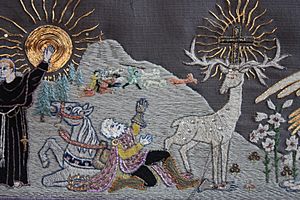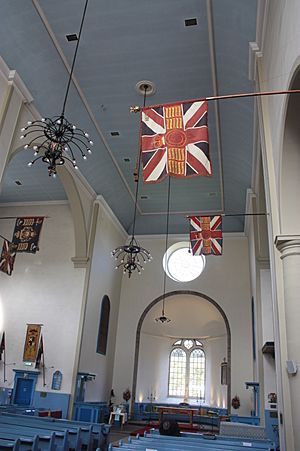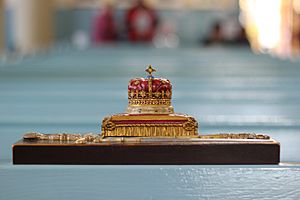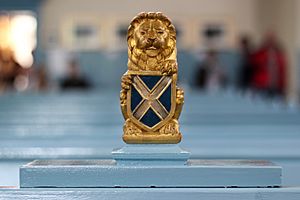Canongate Kirk facts for kids
Quick facts for kids Kirk of the Canongate |
|
|---|---|
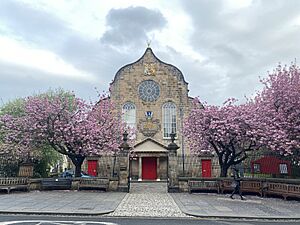 |
|
| Location | Canongate, Edinburgh |
| Country | Scotland |
| Denomination | Church of Scotland |
| History | |
| Status | Parish church |
| Architecture | |
| Functional status | Active |
| Years built | 1688–1691 |
The Kirk of the Canongate, also known as Canongate Kirk, is a famous church in Edinburgh's historic Old Town, Scotland. It's part of the Church of Scotland. The church serves the area of Canongate, which includes important places like the Palace of Holyroodhouse and the Scottish Parliament. It's also the church for Edinburgh Castle, even though the castle is a bit separate from the main area.
Many important events have happened here. For example, the wedding of Zara Phillips, who is the Queen's granddaughter, and rugby player Mike Tindall took place at the church on July 30, 2011. The late Queen Elizabeth II also attended services at the church when she visited Edinburgh.
Contents
History of the Kirk
Why a New Church Was Needed
After a big change in religion called the Reformation, the people of Canongate used Holyrood Abbey for their church services. But in 1672, the King decided he wanted Holyrood Abbey to be his own special chapel. So, the churchgoers were told to use Lady Yester's Church while a brand new church was built for them.
Building the Canongate Kirk
On June 28, 1687, King James VII ordered that Holyrood Abbey be turned into a Roman Catholic chapel. This meant the Church of Scotland congregation, who had used the abbey for many years, had to leave. The King told the Town Council to find a new place for them. They were to use Lady Yester's Church until a new one could be built in Canongate.
The people of the parish asked the King to use money that a man named Thomas Moodie had left for a new church. This money helped pay for the building. Moodie's family symbol, called a coat of arms, is now on the front of the church.
A famous architect named James Smith was chosen to design the new church. The building was finished in 1691, and the congregation moved in. The new church cost about 34,000 merks, which was a lot of money back then!
The Kirk in the 1700s
In 1745, during a time of rebellion led by Charles Edward Stuart, his army took over Edinburgh and the Canongate area. The church was even used to hold prisoners from a battle.
By the end of the 1700s, the church was getting too crowded. So, two smaller chapels were built nearby to help more people attend services.
Changes in the 1800s
A Time of Decline
In the 1800s, the Kirk of the Canongate started to lose some of its special connections. The King and Queen used to be patrons of the church, meaning they supported it, but this link ended after 1856. The city council also used to worship there, but this stopped too.
The area around the church also changed. Many people moved to the New Town, and the Canongate became a less wealthy area. One minister described the parish as having "dismal abounding of iniquity," meaning there were many problems.
A New Beginning
Despite these challenges, the church began to revive. In 1843, when the Church of Scotland split, most of the Canongate Kirk members stayed with the original church.
A new minister, Andrew R. Bonar, arrived in 1849. He brought in new ideas, like hymn-singing and a choir. A pipe organ, one of the first in the Church of Scotland, was added in 1874. Sadly, a fire in 1863 damaged the church and likely destroyed many old church records.
When James McNair became minister in 1869, the church had about 500 members. Just four years later, that number had doubled! Famous American preachers, Ira D. Sankey and Dwight L. Moody, even held meetings at the church in 1874.
The Kirk in the 1900s and 2000s
Thomas White was the minister from 1889 to 1936. During the First World War, many men from the Canongate area joined the army, and 90 members of the church lost their lives.
In 1937, Ronald Selby Wright became the minister. That same year, King George VI gave the church a Christmas tree from his home at Balmoral. This tradition has continued every year since!
The church was renovated starting in 1947. On July 17, 1947, Queen Elizabeth and Princess Margaret visited. This was the first time royalty had ever visited the church, even though it had a special "royal pew." This connection grew stronger when the Queen visited in 1952, her first visit as monarch. Since then, the Queen and other royals have often visited the church for services.
The Canongate area itself also improved greatly from the 1950s onwards. The Scottish Parliament Building opened nearby in 2004, and the University of Edinburgh also grew in the area. The church opened new buildings to support students and the community.
Building and Churchyard
The Kirk's building has a unique look with a Dutch-style roof and a small entrance porch. On top of the roof, there's a golden cross inside a pair of antlers. These antlers are from a stag shot by King George VI at Balmoral in 1949. They represent the old symbol of the Canongate area.
Inside, the church has a cross shape, which was unusual for churches built in Scotland after the Reformation. The inside was changed a lot in 1882, but then restored in the 1950s to its simpler, original style. A new Frobenius pipe organ was installed in 1998. This was the 1000th organ built by the Frobenius company!
You can find a special Royal Pew and a Castle Pew in the front row of the church.
The Canongate Churchyard is a burial ground where many famous people from Edinburgh are laid to rest. These include the important economist Adam Smith, the philosopher Dugald Stewart, and the poet Robert Fergusson. A statue of Robert Fergusson stands outside the church gate.
What the Kirk Does Today
The Kirk of the Canongate has a very active church community. They hold a service every Sunday morning at 10:30 AM, plus a monthly evening service. The church building is also often used for concerts.
During the yearly Edinburgh Festival, the Kirk becomes a popular venue for music and other events. It's also the special chapel for The Royal Regiment of Scotland, a part of the British Army.
Ministers of the Kirk
The Canongate Kirk has been served by many well-known ministers over the years. Some have even been chosen as the Moderator of the General Assembly of the Church of Scotland, which is a very important role.
The first minister of the Kirk was Very Rev Thomas Wilkie, who served from 1689 to 1711. He was Moderator twice.
One famous minister was Rev Robert Walker, who served from 1784 to 1808. He worked to end the slave trade. He is also famous because he was painted by Henry Raeburn in a painting called The Skating Minister, which shows him skating on a frozen loch.
The Very Reverend Dr Ronald Selby Wright, known as the "Radio Padre" because of his broadcasts during wartime, was minister from 1937 to 1977. He was Moderator in 1972. While Dr. Selby Wright was away serving as a military chaplain, Revd George MacLeod (who later founded the Iona Community) filled in for him.
The current minister, since June 22, 2006, is the Reverend Neil N. Gardner. The church's organist and Director of Music is Simon Leach.


